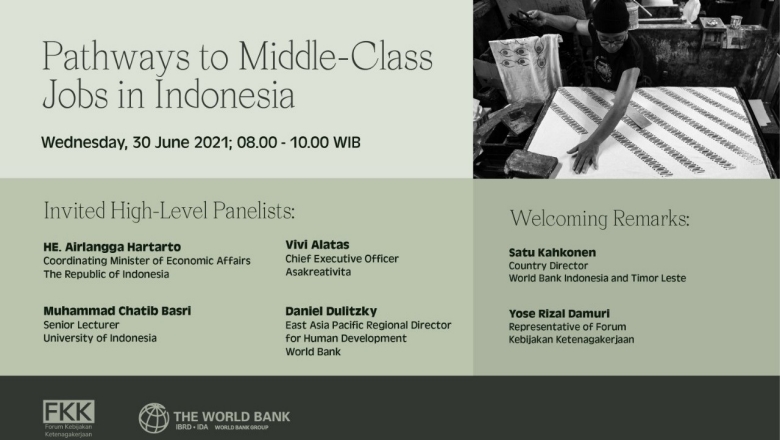Download: Technical report (.pdf) | Overview (.pdf) | Presentation (Video | slides)

Key findings
Between 2009–2019, Indonesia created an average of 2.4 million new jobs each year. In 2019, there were more than 120 million working youth and adults in Indonesia. The employment rate reached a two-decade record high in 2019, with 67.5% of youth and adults in the labor force, and unemployment fell to its lowest level in two decades, at 5.2%.
Despite these encouraging signs, Indonesia is not creating the middle-class jobs needed to fuel a middle-class country. Almost half of Indonesians are still stuck in Aspiring middle-class status – those who have moved out of poverty but still have not reached the middle-income bracket. .
Fundamentally, a middle-class job is one that furnishes a worker with sufficient earnings for them to provide a middle-class standard of living for their family. Among the 85 million income earners (wage employees, casual workers, and the self-employed), only 13 million (15%) are earning a level of income sufficient to allow a family of four to purchase a middle-class way of life. Only 3.5 million wage employees earn above the threshold for middle-class earnings, enjoy full social benefits, and hold an indefinite-term employment contract.
- Jobs created through structural transformation—transition of the workforce across economic sectors over time, including out of agriculture—have not brought the productivity gains needed to create middle-class jobs. Over the past two decades, most new jobs were in low-productivity services, where labor productivity is not significantly higher than in agriculture.
- The structure of Indonesia’s firms sector is not conducive to create middle-class jobs. Indonesian enterprises are created and remain small. They are not significant creators of middle-class jobs. Two-thirds of jobs are in household enterprises, with 45 million owners and 38 million workers, nearly all of whom are informal. The manufacturing sector—the source of many jobs in the 1980s and 1990s—creates some jobs, but they are increasingly in old and very large firms (at least until 2015). Further, medium-sized and large foreign manufacturing firms, who hire more than domestic firms and pay higher wages, are less prevalent in Indonesia than in regional competitors that have leveraged foreign direct investment (FDI) for rapid economic and job growth.
- Indonesia’s workforce is not equipped with the skills needed to carry out middle-class jobs which tend to be in more-skilled occupations. However, 57% of the labor force has a lower-secondary education or lower. Learning outcomes are also poor. An Indonesian child entering the education system today is expected to complete 12.4 years of schooling, but will only learn the equivalent of 7.8 years.
The report highlights three policy reform areas:
- Promote productivity growth across the board, not least in sectors with low value added. The most promising route to increasing productivity is enacting competition-enhancing policies, including those that lower the high cost of trade, increase access to foreign talent to fill roles for which there is a shortage of domestic workers, and attract export-oriented, efficiency-seeking FDI with links to global value chains. Competition-enhancing policies also include those that create a more predictable and level playing field for firms, and those that strengthen institutions that promote competition and sound business regulation. Indonesia will also need to make a concerted effort to support productivity growth in household enterprises and small, and medium-sized enterprises.
- Facilitate a more decisive shift in economic activity and workers toward more productive and higher-paying firms, sectors, and jobs. Indonesia could prioritize certain policy reforms in sectors which are likely to create middle-class jobs. For example, prioritizing investment promotion strategies to attract FDI which are likely to be sources of middle-class jobs. Tax incentives are often considered but they are challenges in Indonesia. The country already collects less taxes than most of its peers and as a result has a revenue base that is insufficient to sustainably fund the public services, such as infrastructure, that could attract high-quality investments. Moreover, if workers are to transition across sectors, firms, and occupations, they also need robust information systems, a strong job-matching mechanism, legislation that does not disincentivize job changes, and support for job movements—including unemployment insurance—so that they may appropriately prepare for, and advance to, these better jobs.
- Build a workforce that has the necessary skills to take on the new jobs in higher value-added and internationally competitive sectors. This will require changes to the education system to better prepare today’s youth for modern jobs. Perhaps more challenging, however, it will also require innovations to upskill the current adult labor force, enabling them to benefit more from potential technology transfers and spillovers of FDI from multinationals. Additional support to attract women and youth into the workforce is increasingly necessary as the share of the working-age population begins to shrink.
The Asian financial crisis had such an effect. However, with careful planning to build back better, the disruption could be an opportunity to systematically and strategically map out a recovery agenda that focuses on productivity and good jobs.
MULTIMEDIA
